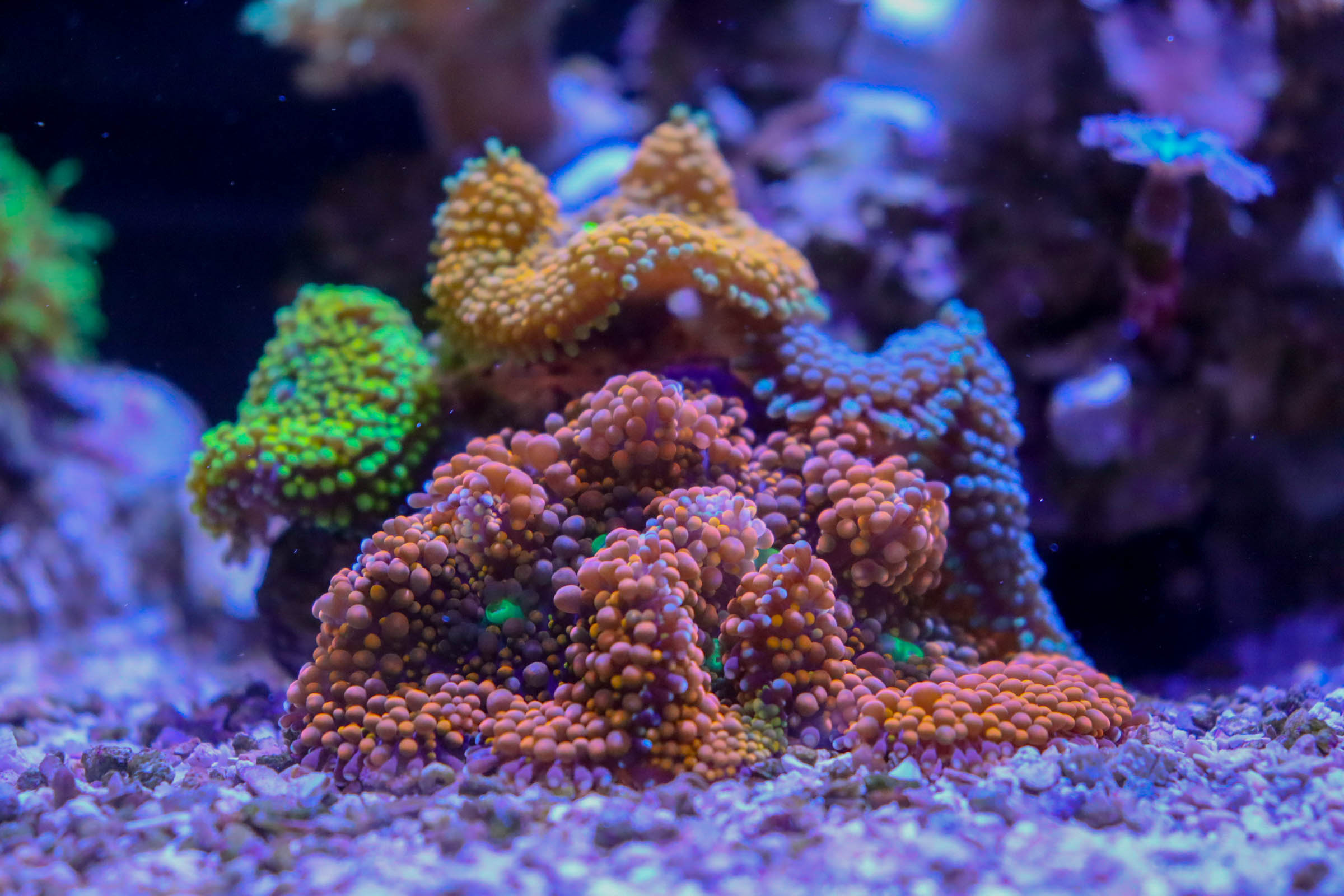Florida Ricordea Mushroom
Placement: Low to Middle
Light: Low – Very Low
Flow: Low-Medium
Care Level: Easy
Type: Soft Coral
Compatibility: Semi-Aggressive
Growth Rate: Moderate
Photosynthetic: Yes
What is a florida ricodea ?
Florida Ricordea Mushrooms have some unique characteristics that set them apart from other members of the Corallimorpharia order.
Like other mushrooms, they are not technically true corals, sharing some characteristics with anemones as well as both hard and soft corals.
How are florida ricordea different from other mushroom corals ?
What makes Florida Ricordea mushrooms unique is the texture that is created by its small tentacles. These unique mushrooms often have distinctive rings of color that radiate out from a central mouth. The rings of tentacles will often be alternating colors, giving the Florida Ricordea a “bulls eye” like appearance.
Reproductions differences from other mushrooms.
Another thing that sets Florida Ricordea mushrooms apart from most other types of mushrooms is their method of reproduction.
Rather than producing small babies like Discosoma or Rhodactis mushrooms, Florida Ricordea reproduce by splitting. In this process, the mushroom will “pinch” at the mouth and eventually divide into two separate specimens.
Florida ricordea can come in almost every single colour variety as shown above
How are they different than yuma mushroom corals ?
While most hobbyists will agree that the vast majority of the most colorful corals in the reef keeping hobby come from the Indo-Pacific region, one notable exception is the Florida Ricordea mushroom. These beautiful corallimorphs are actually a type of Yuma mushroom and are closely related to their more widely known Pacific cousins.
What differentiates Florida Ricordea mushrooms is the texture that is created by its small tentacles. T
hese unique mushrooms often have distinctive rings of colour that radiate out from a central mouth. The rings of tentacles will often be alternating colors, giving the Florida Ricordea a “bulls eye” like appearance.
Color varities of ricordea
Because they come in a wide variety of color morphs, it is common for reefers to place a variety of different colored specimens in close proximity to create a carpet-like effect. While they do have a mild sting, they can be placed in direct contact with other Florida Ricordea mushrooms without any fear of coral warfare. A rock covered in these beautiful mushrooms makes a great centerpiece for a smaller tank, with the added bonus of being very easy to care for.
Due to its unique appearance and wide variety of available colors, the Florida Ricordea mushroom is seen as a “must have” by many reefers.

Where are Florida Ricordea found ?
Not surprisingly, Florida Ricordea mushrooms are found in the Caribbean, particularly in the waters surrounding the Florida Keys.
These fascinating mushrooms prefer to attach themselves to rocky substrates, including coral reefs and rocky outcrops. They are often found in shallow, sunlit areas of the ocean, usually at depths ranging from 5 to 50 feet.
Natural Water Conditions of Ricordea
They thrive in warm, tropical waters, specifically in areas with moderate water flow. They can be placed anywhere in the bottom half of a mixed reef tank and do not like direct light.
Ideal Flow Conditions of Ricordea
Flow should be sufficient to prevent the buildup of detritus, but not strong enough that the mushroom is blown around aggressively or folded back on itself.
Aggressiveness
The Florida Ricordea does have a moderately powerful sting so they should be given enough space that they will not sting more delicate corals. They can, however, be placed in a garden with other Florida Ricordea.
Florida Ricordea Food Sources
Florida Ricordea mushrooms are photosynthetic and will use aquarium lighting to meet their energy needs. If desired they can be spot fed a soft coral food, which can help to speed their growth rate, which tends to be slower than most other mushrooms.
Like all mushrooms, Florida Ricordea are photosynthetic and are able to meet all of their energy needs by using the aquarium lighting. They can, however, be fed foods designed for soft corals or generic coral foods, such as Reef Roids. Supplemental feeding will increase their growth rate and may improve coloration. Regardless of whether or not they are actively fed, this type of mushroom will grow more slowly than most other mushroom species, once again a reason why they are a great choice for smaller nano or pico tanks.

How to frag Florida Ricordea
Fragging this type of mushroom is a little bit different than most other mushrooms due to their method of reproduction. Rather than simply cutting a piece of flesh, reefers looking to propagate Florida Ricordea mushrooms will need to wait for them to split naturally and then carefully remove the new mushroom and place it in a low flow area with a piece of rubble rock or frag plug and allow it to attach naturally.
Can I keep them in a nano reef tank ?
Florida Ricordea mushrooms make a great addition to tanks of any size, including both nano and pico tanks. Because they are generally non-aggressive (although they do have a mild sting if they come into direct contact with other corals) and are relatively slow growing for mushrooms, they won’t take over a smaller tank like some other mushroom species will. They are also tolerant of a wide variety of lighting and flow levels and, as such, will thrive in a nano or pico reef tank with less intense lighting. Having said that, they will also do well in a larger mixed reef tank provided they are kept in the lower third of the aquarium. Since space is at a premium in smaller tanks the vibrant colors of Florida Ricordea mushrooms make them a great choice.
While they don’t get as much love as their more well known Pacific siblings, Florida Ricordea mushrooms make a dazzling and unique addition to any home reef tank.






